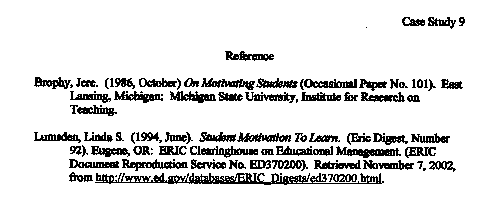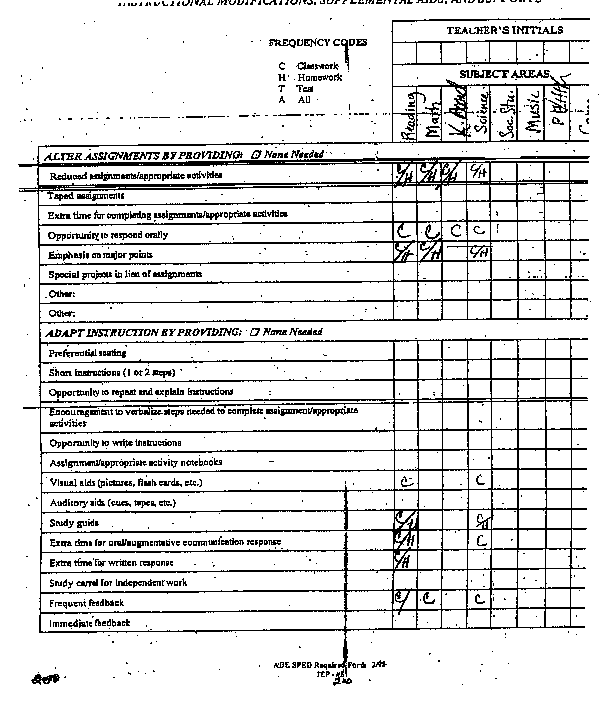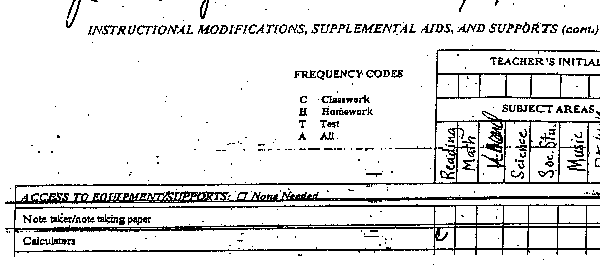
| Introduction | Family Background | Other Background Info. | Teacher Strategies | Alternative Strategies |
| Special Needs | Academic Background | Performance In Class | My Opinion | References & IEP |
Abstract
The following explores Jimís reasons for not being motivated to learn. It is an examination of Jimís special needs, family background, academic background, other information from background, performance in classroom, strategies currently used with the student, opinions, and alternate strategies that are not currently being used.
Introduction
Students fail in school for a variety of reasons. In some cases, their academic difficulties can be directly attributed to deficiencies in the teaching and learning environment. Other students may have learning difficulties stemming from linguistic or cultural differences. Still other students need specialized instruction because of specific learning disabilities. These difficulties may become more serious over time if instruction is not modified to address the students' specific needs. Unless these students receive appropriate intervention, they will continue to struggle, and the gap between their achievement and that of their peers will widen over time. However, when it is all said and done, the student has to take some ownership, some initiative, have some intrinsic motivation.
Linda S. Lumsden (1994, June), in her article, Student Motivation to Learn, states that student motivation naturally has to do with students' desire to participate in the learning process. This statement is the underlying reason for the problems facing the learning of the student that will be discussed in this paper. The student, who will be called Jim for this assignment, has varying interest in life outside of the classroom instead of inside the classroom. Jim is a student who is moving from resource classes to the regular mainstream classes. Jim knows that school for him has now become more challenging. Therefore, he has made a conscious decision to become dishearten and his desire to participate in the learning process has become null. The majority of this paper is taken from Jimís point of view. He was in an environment in which he was free to share any information that he wanted to. Yet, when it came to his academic involvement, he tended to stray away from discussing it. I constantly had to continue bringing that area up for discussion.
The following paper will explore Jimís reasons for not being motivated to learn. The paper will look at Jimís special needs, family background, academic background, other information from background, performance in classroom, strategies currently used with the student, my opinions, and alternate strategies that I would suggest that are not currently being used.
Jimís reading and writing class is the class that I observed. Jimís teacher, who we will call Mr. T for this assignment, addressed Jimís special needs with me. Mr. T stated that Jimís special need was speech. Mr. T explained that Jim is in resource and needs additional one-on-one help. Jim receives speech therapy twice a week.
Jim, who is about thirteen years of age, had much to say about his family. His step dad lives in Helena with Jimís Aunt; she is sick. Jimís biological dad lives in Florida with his two sons and four daughters. Jim has six stepbrothers on his fatherís side. He has two twin brothers (both one year olds) that live with him and his mother. He cooks for his brothers (baby food etc.); the twinsí birthdays are the same as Jimís.
Jim has another brother that lives in Little Rock, but that brother has the same mother as Jim, different fathers. When Jim was a baby, he rarely ate. He had to go to the doctor many times. A car hit him when he was three; the car ran over his leg. His mother and father had many problems when they were together. His mother has been the only person and still is the only person that helps him with his homework.
Last year, in Jimís fifth grade career, he made all Aís at Geyer Springs. He was mainly in resource classes. This year his academic career is not going well. He has mostly regular classes. He has problems with his teachers. His keyboarding teacher says he does not do his work. He says people steal his work.
Math is very hard for him. He gets help from the teacher, but his mother works many late nights and is unable to help him.
Jim uses hooked on phonics. He thought his friends would embarrass him, but they never see it and do not know that he uses hooked on phonics. He uses hooked on phonics to help him with math and reading. He says his social studyís class is easy for him.
In his gym class, people try to fight him all the time (he refuses to fight). One guy fought him because Jim tackled him playing football. The guy pushed Jimís head against a locker and kicked Jim as well. Also in gym class, other students make fun of Jimís last name. Jim tells the teacher, but the teacher will not do anything about it.
In science, he stated that he has missed too many days. Jim went on to say that the work was too hard for him. He said that he does not write as good and he does not feel like doing the work. Plus, his mother does not help him with science.
Jim informed me that he has an, ĎFí in his reading and writing class. Jim said that he does the work, but he does not get good grades. He does not like to read and write. He says the teacher gives the students too much to do. Jim further exclaimed that his teacher is sometimes in a bad mood. So, Jim does not like to ask him for help. Jim explained that he needs a lot of one-on-one help in all of his classes.
Other Information from Background
Jim had to attend a funeral the day before Thanksgiving. His Aunt died of breast cancer. Previously this year, his mother had a miscarriage (last January). She was in an accident. His little cousins died at the age of one. His mother and his motherís sister got pregnant at a young age (18 or 19). Jimís mother is very paranoid of him having a girlfriend for fear that he will follow in her footsteps and have a child at a young age.
Jim has also had a few run-ins with the law. He got in trouble for beating up a handicap person. He stated that the handicap person hit one of his little twin brothers with a rocking chair because his little brother hit the handicap person first. His mother called the police on him (Jim). Jim stayed in a juvenile center for two days.
Jim stated that when he was in Helena, at the age of eleven, he went to the juvenile center for nine months. A friend of his is in the juvenile center at Roosevelt. His friend, X (name unknown), beat his on mother up (Xís mother). X beat his mother up with a stick when X was eleven. Xís mother was sleep and X hit her with a 2 x 4. X went to court and was sentenced for 22 years.
The teacher, Mr. T, stated that Jim is not putting forth any effort. Jim knows that he will pass the class, after being held back for one year (students can not stay in sixth grade after two years of sixth grade Ė they must pass on). The student knows the assignments and knows that all he has to do is a minimum of the workload. Yet, the student still does not do the work. The student does not hold himself accountable for any work assigned. The teacher also informed me that his class is a regular class, not a resource class, and the parents knew that the student would have a hard time in a regular class. Mr. T reaffirmed that Jim does have an, ĎFí in his class.
Strategies currently used with student
Reading and Writing Class/Workshop
The teacher, Mr. T, has made many modifications for Jim for the reading and writing class. Those modifications include adaptations of instruction, materials, tests, altered assignments, and emphasis on major points.
The teacher adapts instruction by providing peer tutoring/paired working arrangements for class work as well as by using visual aids (pictures, flash cards, etc.) in the classroom. Even more, Mr. T adapts instruction by providing study guides, extra time for oral/augmentative communication response, and extra time for written response for class work and homework; Mr. T gives frequent feedback for class work.
The teacher adapts materials by providing peers the chance to read materials for class work. Mr. T provides study aids/manipulatives during class work.
Mr. T adapts tests by providing a word bank for class work. He, the teacher, eliminates essay sections for class work and tests. He also reduces the option of multiple-choice questions for class work.
Mr. T alters assignments by providing reduced assignments and appropriate activities for class work and homework.
Many of the above techniques are shared with Jimís other teachers, such as math and science.
In summary, I believe Jim has a lot of potential and he must understand that. As far as the teachers/educators, I believe the challenge for educators is to provide an appropriate balance for Jim to develop both intrinsic motivation and extrinsic motivation.
Teachers, parents and other influential factors can provide the optimal challenge and the problem solving support for academic success and a sense of flow. Furthermore, Jimís teachers must continue or give more of a sense of intrinsic motivation for him by improving instructional practices that promote interest and success.
Alternative strategies that I would suggest
I believe that when it all boils down to it, concentration on Jimís motivation to learn is the key to getting him on track. A process called ATTRIBUTION RETRAINING, which involves modeling, socialization, and practice exercises, is sometimes used with discouraged students. The goals of attribution retraining are to help students to (1) concentrate on the tasks rather than becoming distracted by fear of failure; (2) respond to frustration by retracing their steps to find mistakes or figuring out alternative ways of approaching a problem instead of giving up; and (3) attribute their failures to insufficient effort, lack of information, or reliance on ineffective strategies rather than the lack of ability (Brophy, 1986). I believe an effective and correctly implementation of this process would help Jim very much.

Student's IEP


Back to Strategies Currently Used